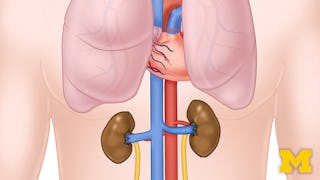This course explores the structure and function of the cardiovascular system, providing a comprehensive foundation in both anatomy and physiology. Learners will study the heart’s chambers, valves, and conduction system, as well as the major blood vessels that maintain systemic and pulmonary circulation. The course also examines key physiological principles such as cardiac output, blood flow regulation, and blood pressure control. Through detailed visuals, clinical examples, and guided review materials, students will develop a clear understanding of how the cardiovascular system sustains life and responds to physiological demands—essential knowledge for nursing, medical, and allied health education.



Cardiovascular System: Anatomy & Physiology
This course is part of Medical-Surgical Nursing: Cardiovascular & ECG Essentials Specialization


Instructors: Darren Salmi, MD, MS
Access provided by ExxonMobil
Recommended experience
What you'll learn
Identify the structural components of the heart and great vessels
Describe the pathway of blood flow through the circulatory system
Explain how the cardiac conduction system coordinates heart function
Discuss the physiological factors influencing cardiac output and blood pressure
Skills you'll gain
Details to know

Add to your LinkedIn profile
9 assignments
October 2025
See how employees at top companies are mastering in-demand skills

Build your subject-matter expertise
- Learn new concepts from industry experts
- Gain a foundational understanding of a subject or tool
- Develop job-relevant skills with hands-on projects
- Earn a shareable career certificate

There are 2 modules in this course
The cardiovascular system consists of the heart, blood, and blood vessels. As this course provides a detailed look at the structure of this system, a basic understanding of the function of the cardiovascular system would assist in comprehension. A healthy understanding of the structure of the cardiovascular system is vital for every nurse regardless of their place of work, as nearly every nursing intervention has the potential to impact this system.
What's included
6 videos6 readings3 assignments
This module provides essential knowledge of cardiac physiology critical for nursing practice. Students will explore the basic structure and function of the heart, the mechanisms that regulate cardiac rhythm, and the components of a normal cardiac cycle. The module emphasizes key cardiac parameters including stroke volume and cardiac output, the electrical conduction system of the heart, and the interpretation of heart sounds. Students will examine electrocardiogram basics and learn to recognize normal cardiac function. The module also addresses common cardiovascular disorders and their clinical management, preparing students to identify significant changes in patient status such as cardiac arrhythmias, blood pressure variations, perfusion changes, and altered urine output. Through this exploration, learners will develop the cardiovascular knowledge necessary to monitor patients effectively, recognize early warning signs of cardiac compromise, and respond appropriately during cardiac emergencies and resuscitation efforts.
What's included
18 videos5 readings6 assignments
Earn a career certificate
Add this credential to your LinkedIn profile, resume, or CV. Share it on social media and in your performance review.
Offered by
Why people choose Coursera for their career




Explore more from Health

University of Michigan

Rice University

Duke University


